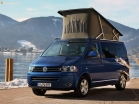Test Drive Volkswagen California since 2010 Minivan
Test Drive Volkswagen Caravelle and Hyundai H-1: Fighting in the weights weight
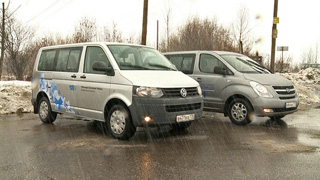 Kolesa.ru portal found out how passengers have a large minibus on each of the seats, whether the driver is convenient to control a large machine in the city and which combine the engine and gearbox is better as a multi-day machine.
Kolesa.ru portal found out how passengers have a large minibus on each of the seats, whether the driver is convenient to control a large machine in the city and which combine the engine and gearbox is better as a multi-day machine. The dominance of compact representatives with the third near the unaware of the marketers of automotive concerns without a branch of conscience is trying to plant and adults often make potential buyers pay attention to more roomy cars.
But no one is in a hurry to buy them. Residents of megacols are experiencing over the size of minibuses, in which they have to pushed in a close city. Someone scares the price, and someone simply does not decide to become the owner of the minibus. Here are the manufacturers of minibuses on a commercial department, which sells such cars to organizations for official use.
But how much minibus is useful and convenient in the hands of a large family man, we will try to find out with the example of Volkswagen Caravelle and Hyundai H-1.
Both cars are in the intermediate class between passenger minivans and passenger vans. And I must say, this class is not completely numerous. In addition to the test cars, it can be attributed to it, except that Mercedes Viano and Toyota Alphard, which are more expensive and fight for buyers with Volkswagen Multivan the most rich version of the conveyor. Karavella is more democratic, and in its price category Hyundai H-1 The only direct competitor.
External data for such cars factor is not even secondary, but tertiary. However, their fans will be found at the chopped rigor of Folksavagen, and the Asian smoothness of Hönde. In any case, both minibuses are an elongated cube, since it is this form that is most suitable for a convenient organization of internal space.
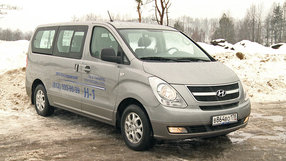
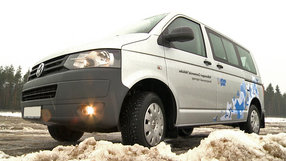
Passenger compartments and Germans, and Korean have two rows of three-beds separating seats, on which all passengers will not be crammed in stock of free space. In addition, both cars offer a complete set of pockets, cup holders and individual blowing deflectors to everyone who will be in the cabin. And the German car also has curtains on the windows. On the third row, it is easier to fall in Volkswagen due to the easiest transformation of the extreme seating of the second row. But in H-1 you can go with both sides: the sliding doors are both on the right, and on the left.
If necessary, both cars can be turned into trucks, folding or removing passenger places at all. Moreover, in the transformation, Hönde turned out to be a little ahead: the back of the sofa of the third row can be folded in parts and transport six people along with the long side of the right side. Karavellah's last sofa and, folding it, three seats are automatically lost.
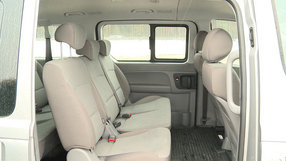
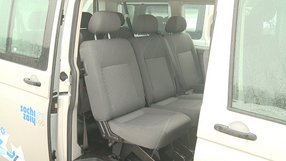
Differences in the driver's zone are noticeably more. Volkswagen nominally ninetyle. In contrast to the full-fledged single nuclear seating of Hyundai H-1, on the bench next to the driver of Karavellas will be able to be pressed. True, it will not be comfortable in this case anyone. In addition, the front passenger Hönda, if necessary, can move freely into the second row and back, without leaving the car.
But, in terms of ergonomics of the driver's seat, Volkswagen is traditionally at the height: the management bodies of all secondary functions of the car are located in logical and intuitive places. Yes, and the salon looks good. To Hyundai H-1, by and large, also some complaints. The driver of the Korean car is not enough to adjust the steering wheel on the departure and right armrest.
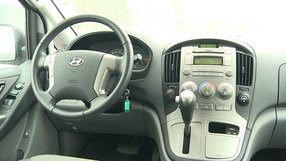
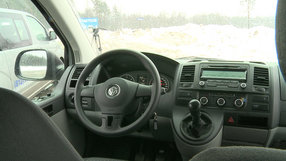
But differences in technical equipment between the test cars turned out to be so much that at first we even laughed in the objectivity of such a comparison. The fact is that the front-wheel drive Volkswagen Caravelle got to us with a two-liter turbodiesel with a capacity of 102 horsepower and a mechanical gearbox, while Hyundai H-1 is driven by rear wheels, a 174-strong gasoline engine 2.4 and automatic.
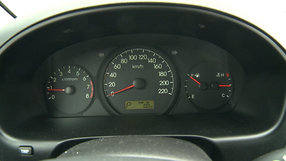
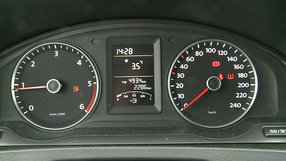
But we have not found any other options for minibuses. So we will find out which combination is more suitable for a major minibus.
Let's start with Hyundai H-1. Despite the significantly superior power, gasoline Korean loses to diesel German in the traction moment. In addition, Hönde is almost 200 kg heavier, and together with a smooth, but a non-historical four-stage automaton overclock H-1 to 100 km / h for infinite 18.5 seconds. In the city, of course, the speed characteristics are not so important, but on the track will have to move over the wagons all the time, since each overtaking will be a check for the nervous system. On the other hand, you will go fish further, especially with six-family passengers on board. But the decent gasoline fourth of Hyundai after 3000 revolutions already explicitly lack.
Volkswagen is not much faster. However, the peak torque available in diesel with 1500 revolutions allows Karavel to move more confident, especially if you quickly wrap a clear lever of mechanical gearbox. And the most interesting thing is that the sound of the Tractor motor Volkswagen turned out to be noticeably quieter than Hyunda's gasoline engine.
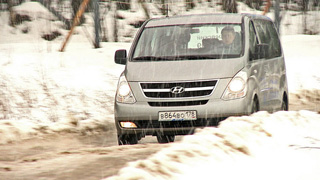
The eternal question about the drive on which wheels is better, in the case of minibuses is solved in favor of Volkswagen Caravelle. If, when driving on asphalt, the difference is practically imperceptible, then on the zoyarey parcel road, the rear-wheel drive H-1 had to pick up in each turn. And icy pits, covered with snow, became for Hyundai, with an unloaded feed, an obstacle even on studded rubber.
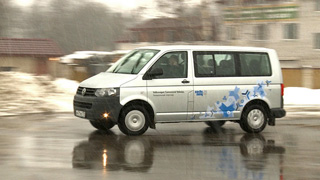
Summing up, we can say that both cars were worthy of rivals and some global advantages do not have each other. These are very functional and convenient cars that will be irreprenerable assistants in a large family.
Passengers of the second and third row, as well as baggage will be slightly more convenient in Hyundai H-1, the driver is definitely in Volkswagen Caravelle. True, the German minibus has a big list of additional equipment and equipment, including for organizing a passenger compartment. But the price in this case will notice the upwards.
Yes, and a heavy diesel engine for a heavy machine suits better than the Korean manufacturer was also convinced. At the time of writing this material, it was about the fact that Hyundai H-1 2.4 AT was removed from deliveries to Russia. Instead of a 174-strong gasoline engine, the H-1 automatic transmission will receive a 2.5-liter turbodiesel with a capacity of 170 horsepower.
The cost of Volkswagen Caravelle and Hyundai H-1 in the Russian market
Volkswagen Caravelle - from 1 368 600 to 2 223 600 rubles
Hyundai H-1 - from 1 269 900 to 1,414,900 rubles
The editorial board of Kolesa.Ru thanks the auto center of the classics and auto center RRT-Piskarevsky for the cars provided.
A source: Magazine "Wheel" [March 2012]

